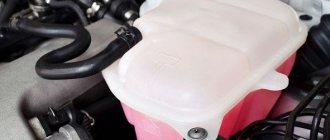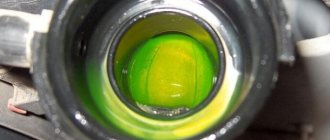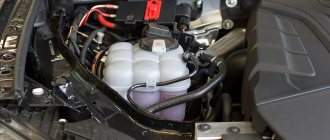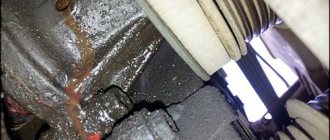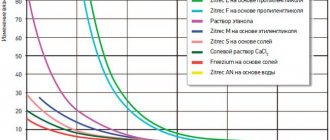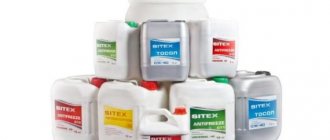To ensure high-quality cooling of the car’s power unit and prevent its possible overheating, refrigerants are used. For these purposes, it is customary to use a special fluid that will meet the engine specifications. If the wrong substance is put into the system, it can cause serious problems. But it happens that a motorist may simply not know what is poured into the system: antifreeze or antifreeze. This usually happens when the car was purchased secondhand and the new owner simply forgets to ask the old owner of the car about it. Sometimes this information needs to be found out because certain malfunctions have begun to occur with the cooling system. Usually, if this happens, it indicates a poor-quality refrigerant. In any case, every motorist should have this information, at least in order to understand what liquid to buy if necessary.
About colored antifreezes
The product itself is colorless. The colored liquid is made from the dyes included in the composition. It is due to these substances that the coolant acquires one color or another. Antifreezes are colored so that the car enthusiast can distinguish the products from ordinary water. The basis of any coolant is ethylene glycol. It is dangerous and poisonous to humans. In addition, colored antifreeze helps identify leaks in the system. And finally, the shades indicate some of the properties and characteristics of the liquid.
How to find out the type of coolant?
In order to find out exactly what is in your tank, you need the help of specialists. Namely, laboratory research, which will have chemical equipment in its arsenal.
If you buy a new car, then immediately rinse the tank and fill it with the antifreeze you need, so that you don’t have problems in the future and don’t wonder what kind of liquid it is. Replacing the coolant is inexpensive, but it will protect your car from overheating or engine frostbite. It will be much more expensive to replace the engine than the coolant.
← Previous material
Next material →
G12: red and its shades
G12 coolants are traditionally produced in red and its shades. This is anything from pink to maroon. Experts classify this mixture as the carboxylate type. The composition contains organic additives that have a selective effect. The liquid creates a durable protective layer only on those surfaces where there are already pockets of corrosion. These antifreezes were developed in the 90s. These fluids are excellent for working with high-speed and hot engines. This composition serves no more than 5 years.
This composition was developed in 2008. These fluids were widely used by the Peugeot-Citroen group in new models. As for the color, it is also traditionally red. These hybrids are similar to G11. But it contains fewer chemical reagents. Organic matter here is about 50 percent.
Modifications of red antifreeze
To solve problems with corrosion formations in the system, antifreezes were developed, called G12+, G12++. Which differ from G12 by the addition of chemical additives in an amount of 10-15% of their total volume.
Thanks to the preventive functions of inorganic compounds, it was possible to achieve less formation of corrosion centers without a significant loss of heat transfer.
Yellow antifreeze (G13) . Developed by VAG in 2012 specifically for its cars. The original color used on German cars is purple.
The base contains propylene glycol and distilled water. Compared to ethylene glycol, this compound is practically harmless. The addition of hybrid additives (organic and chemical) to its composition increases its preventive and protective functions. Freezing temperatures are about -40 degrees. Boils at +140 degrees.
So what about the color
There are several opinions on this matter, but the truth has not yet been revealed. Some information does appear in the public domain. At first glance, there are few differences between colored liquids - these are additives. But a large army of car enthusiasts forget that each series of cars uses different types of radiators and different engines. If the radiator is copper, then it is worth remembering what color the antifreeze is and what the car manufacturers recommend. For such heat exchangers, it is recommended to use the red version. If the radiator is aluminum, then green will do.
What to choose
Often, novice car owners try to purchase coolant based only on its color. This is not entirely correct. It is best to focus on classes. This is the only way to acquire true, proven quality. And if you focus on which antifreeze is better in color, you can buy regular antifreeze instead of the G11 product under the guise of a quality product. And again, you need to look at the class of coolant for a particular car, as well as the material from which the radiator is made. Only after this do we pay attention to the colors of the liquid. As for a quality product, you can pay attention to Sintek products. Here you can choose by color. And for those who don’t know what color Sintek antifreeze comes in, let’s say - all the colors described above.
As you know, antifreeze (coolants) are necessary for the cooling system to operate any vehicle. They perform the function of cooling the engine and help prevent it from overheating. Today we will tell you how green antifreeze differs from Tosol and what are the characteristics of these liquids.
If you know the difference between liquids of different colors, but are not familiar with what technical characteristics correspond to green refrigerants, then we will tell you about it. One way or another, green antifreeze is a type of coolant, and this concentrate has recently become increasingly popular among domestic motorists.
Filling coolant into the expansion tank
How to spot fake antifreeze
The quality of the coolant is of great importance. Non-compliance with the declared properties can result in serious problems for car owners.
A low boiling point may cause the engine to overheat.
Lack of crystallization and high freezing temperatures can damage the cooling lines, cooling radiator and cylinder block of the internal combustion engine.
When purchasing coolant, it is better to contact sellers with a good reputation who have been on the market for a long time. Having a quality certificate will reduce the likelihood of purchasing counterfeit products.
Even in this case, the buyer is not immune from counterfeiting. A few tips that can help you choose and fill in high-quality antifreeze.
The first thing you should pay attention to is the quality of the packaging and stickers. A poorly printed sticker that barely stays on or a deformed canister is the first sign of a counterfeit product.
Strong foaming of antifreeze indicates low quality . Just shake the canister. If the container is not transparent, look at the level line at the end.
All these measures are preliminary and cannot give a definite answer about the quality of the coolant. The following experiments after opening the package will help you achieve more accurate results.
Testing for Ph
This is done using litmus paper. If the acid medium indicator changes color to pink or blue after contact with coolant, it means the antifreeze is of low quality. Green color indicates the correct choice.
Measuring density
Using a hydrometer. Measurements are made on liquid at room temperature (15-20 g). Indicators in the range from 1.071 to 1.104 are the norm. It is recommended to take measurements of the new fluid after a week of use. A large difference in the results indicates density-increasing additives. It is recommended to replace the fluid.
Freezing at home
It is enough to place a small amount of antifreeze or antifreeze in the freezer. Due to the low temperature and small amount of liquid (100-150 ml), conclusions can be drawn after one and a half to two hours. If the viscosity of the fluid has not changed or crystallization has occurred, the antifreeze is of good quality.
Bring to a boil
We use a heat-resistant container. Ethylene glycol is a potent poison. Therefore, it is better to choose disposable containers. If you have a thermometer that allows you to take the necessary measurements, use it. Compare the boiling point with the stated one.
The minimum boiling limit of antifreeze is 110 degrees. If there is nothing to take measurements with, pay attention to the presence of sediment. With low-quality antifreeze, additives fall out.
Characteristics and Features
G11 standard refrigerants are silicate antifreezes. As you know, any coolant (hereinafter referred to as coolant) has no color and is produced exclusively colorless. Refrigerants are “awarded” directly by color by the manufacturer, but all liquids have their own standard, which can match the color.
In particular, G11 standard coolants can be painted in blue, yellow, orange and green. It should be noted that green is one of the most popular and common colors. “Antifreeze” is a domestic analogue of refrigerant manufactured according to the G11 standard. This liquid can interact with all surfaces of the system, simultaneously covering all elements and parts with a protective layer. The service life of green coolant, as a rule, does not exceed three years. However, here too everything depends on the manufacturer - it is impossible to accurately determine the service life of the concentrate.
Red and green coolant of different classes - G11 and G12 - from one manufacturer
Compound
The G11 standard coolant can be based on either ethylene glycol or promylene glycol. Here everything also depends on the manufacturer. As a rule, such coolants are considered the most budget-friendly, and they contain a minimal package of additives. Actually, green color was assigned to this class. By the way, the original purpose of the colors was to distinguish between different classes of refrigerants.
In addition, this coolant can be used as a working fluid in other heat exchange systems that are used at low and medium temperatures.
It should also be noted that this coolant is intended for use in cooling systems of engines that operate on the principle of internal combustion of gasoline. As for the operating temperature range, green coolants are no different from traditional antifreezes: from “-40” to “+50” degrees of ambient temperature.
Drained coolant from the system
Additives
Each individual coolant manufacturer can and does use its own additives. Moreover, in the line of one coolant manufacturer, the number and composition of additives used may differ. And green antifreeze can also have different properties, depending on the additive package used. In particular, additives can be:
- anti-foam (preventing the formation of foam in the cooling system and expansion tank);
- anti-corrosion (preventing corrosion on metal elements of the cooling system);
- preventing negative effects on the rubber components of the cooling system.
What is the difference between antifreeze and antifreeze?
The concepts of “antifreeze” and “antifreeze” are often confused by car enthusiasts. However, many are sure that this is the same product. But is it? Let's consider each of them separately:
Definition:
- Antifreeze is a general name for cooling compounds, regardless of their color, series and year of manufacture.
- Antifreeze is one of the types of antifreeze that was produced in the Soviet Union. Due to the lack of competition in the market, the term took root among domestic car enthusiasts and became a household name. In fact, “TOSOL” has its own meaning: “Technology of organic synthesis of a separate laboratory.”
Performance characteristics:
- Antifreeze is a substance that provides reliable protection of walls from corrosion without affecting heat transfer. The advantages of the coolant are that it does not lose quality even after 250 thousand kilometers. In addition, the composition uses organic salts, which eliminate the appearance of sediment. The boiling point of antifreeze is 115 degrees Celsius. In practice, the average service life of such a coolant is two years or 100,000 km.
- Antifreeze also forms protection on metal walls. The disadvantage is that the thickness of the film formed is about 0.5 mm, due to which heat transfer is minimal. The result is increased fuel consumption and rapid engine wear. To avoid problems, it is recommended to change antifreeze after 35-40 thousand kilometers. Otherwise it becomes useless. Another drawback is the presence of inorganic salts (silicates, phosphates) in the composition, which over time give sediment or acquire a gel-like state. As a result, the radiator becomes clogged and the entire system requires cleaning.
Video “Which coolant is better to fill in your car?”
This video describes the criteria by which you should select a coolant for your vehicle.
Almost every car enthusiast knows that there is antifreeze in a car engine. Many people call it “antifreeze” or “coolant,” but all these concepts are the same thing. Any antifreeze is a liquid containing various additives. In the store you can see green, blue, red, orange antifreeze created for car engines. A reasonable question arises: what affects the color of antifreeze? Let's look into this, and also find out whether it is possible to mix antifreeze of different colors.
Let's compare the properties
To make the advantages, disadvantages and possible compatibility clearer, I will compare liquids by type.
Antifreeze and G11
The color of antifreeze of this classification is green. Comparing the properties of antifreeze with antifreeze of this marking, we are convinced that the domestic liquid corresponds to the imported G11 marking.
The operating principle of their additives is similar - the formation of a film that prevents corrosion of the cooling jacket, radiator, and protects rubber hoses. The disadvantages are the same - the film reduces heat transfer, in the summer the engine gets hotter than with other coolants.
This means that it is permissible to pour one substance instead of another, but they cannot be mixed with each other.
Mixing is a common mistake among amateurs. This causes foaming of the coolant, loss of properties, and sedimentation, which can lead to boiling and overheating of the engine.
Both substances are replaced every two years, this is caused by sedimentation and loss of properties.
Antifreeze and G12
The color of antifreeze of this classification is red, like antifreeze 65. G12 contains ethylene glycol and water, and this is where their similarities end. The additives of this type of antifreeze are organic. Among them, carboxylic acid.
The absence of a protective film improves engine cooling, which is so necessary for high-temperature modern engines. Any rust is instantly dissolved by acid. Serves up to 4 years.
Important: The previous version had chemical additives. These types of additives are incompatible with each other. Mixing G12 with antifreeze or G11 is unacceptable.
This classification of antifreeze is superior to antifreeze in terms of service life and cools better. They can be used in VAZ cars.
Antifreeze and G13
Antifreeze of this type is the pinnacle of the evolution of coolants. The composition is as follows:
- Propylene glycol is considered a non-toxic substance that is safe for human health. (Appears only in formulations marked G13 and higher).
- Distillate
- High quality hybrid additives
If version 11 protects against corrosion, but reduces heat transfer. And 12 does not protect against corrosion, but here the effect is combined. From compatible additives. Mixing with previous versions of antifreeze or with antifreeze is not allowed. Differences between additives will cause foaming, sediment and loss of properties.
These antifreezes are better than previous generations, and are definitely superior to antifreeze in quality.
Is it possible to mix antifreeze of different colors?
Since the color of antifreeze is determined only by the dye, there may be an illusion that all antifreeze is the same. However, as we wrote above, coolants differ from each other, but not in color, but in other parameters. At a minimum, they are divided according to the composition of functional additives into 4 types:
- G11: Hybrid antifreezes, contain organic and inorganic inhibitors;
- G-12, G-12+: Carboxylate antifreezes, characterized by a service life of more than 5 years;
- G-12++, G-13: Contains mineral inhibitors;
- Traditional antifreeze: Considered obsolete, they are sometimes used by car manufacturers when first filling the coolant tank.
The canister in which the antifreeze is supplied always indicates what type it is. It is this parameter that you should look at first if you want to mix antifreeze of different colors.
However, even when mixing antifreeze of the same type, the old liquid can conflict with the new one, as a result of which their protective and cooling properties will decrease or disappear altogether. Even if you mix red G-12 antifreeze with antifreeze of the same color and type from another manufacturer, there are risks of conflicts between the liquids. That is why it is not recommended to mix antifreeze of different colors or the same color - it is better to completely change the coolant in the car so as not to doubt its properties.
If you need to add antifreeze, but you can’t find the same liquid on sale, all that remains is to select the most compatible options. There is a simple folk recipe that allows you to determine whether antifreezes of different colors or the same color are suitable for each other. To do this, coolants are poured into one container and an experiment is being conducted on them. For example, you can take a little antifreeze from a car and the same amount from a new canister. If their consistency does not change when mixing, then everything is fine. But if the mixed liquid becomes cloudy or a precipitate has formed, antifreeze cannot be used together.
Does antifreeze come in red color?
The modern automotive fluid market offers a large number of coolants. Several decades ago, antifreeze was used exclusively, since there were no other options, but for a Soviet car this was the optimal solution. Over time, a unified classification of liquids was introduced with the marking TL 774.
Not everyone knows whether antifreeze is red, this type of coolant is exclusively blue, but in Italy and many other countries it was red. In Soviet times, color was used to determine production, as well as the need to replace and flush the entire cooling system. The service life of antifreeze is up to 2-3 years, and the maximum temperature threshold is not higher than 108 degrees, which is very low for modern transport.




